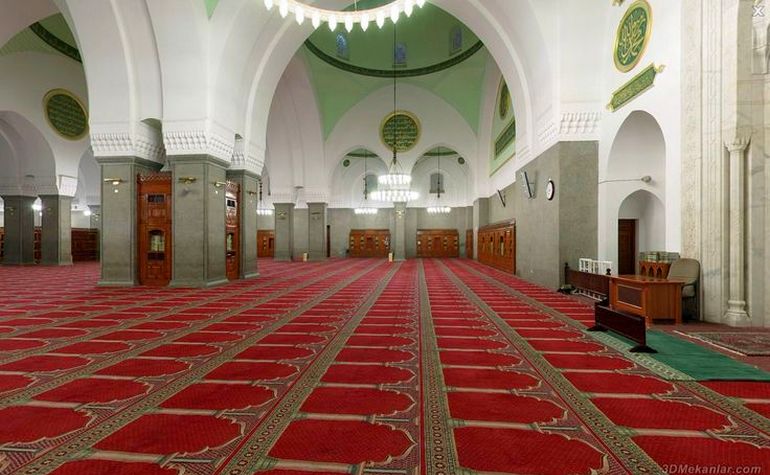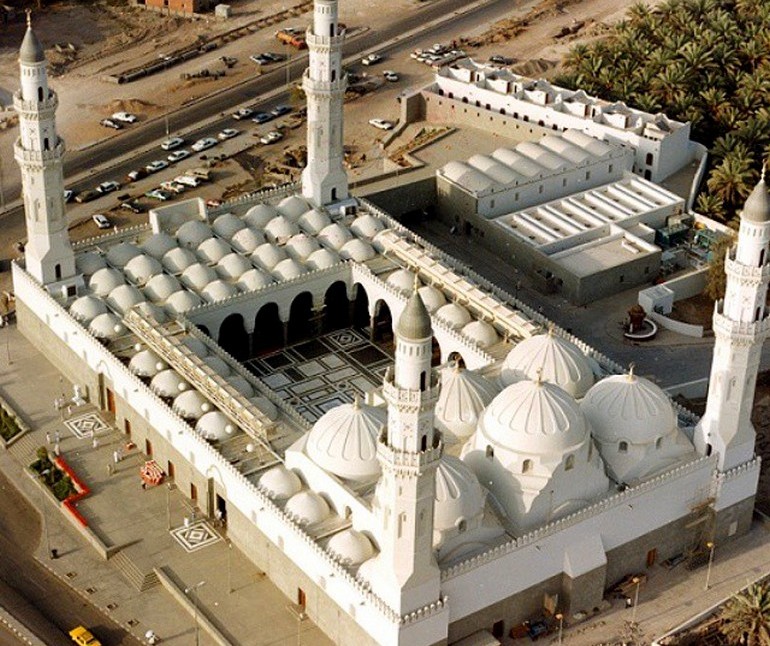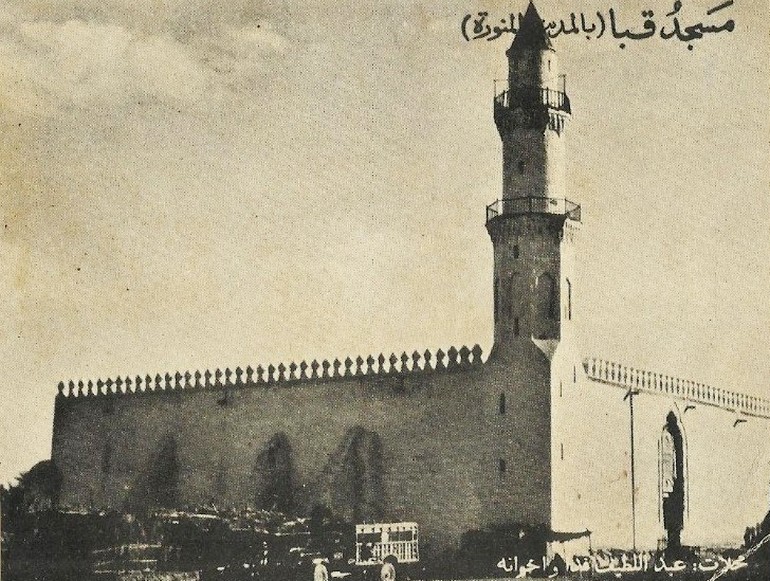
Introduction
The Quba Mosque (Arabic: مسجد قباء, Masjid Qubā’), in the outlying environs of Medina in Saudi Arabia, is one of the oldest mosques in the world. According to legend, its first stones were positioned by the Islamic prophet Muhammad as soon as he arrived on his emigration from the city of Mecca to Medina and the mosque was completed by his companions. Muhammad spent 14 days in this mosque during the Hijra praying qasr (a short prayer) while waiting for Ali to arrive in Medina after the latter stayed behind in Mecca to carry out a couple of tasks entrusted to him by the Prophet.
According to Islamic tradition, performing wudu in one's home then offering two rakaʿāt of nafl prayers in the Quba Mosque is equal to performing one Umrah.
Muhammad used to go there, riding or on foot, every Saturday and offer a two rak'ah prayer. He advised others to do the same, saying, "Whoever makes ablutions at home and then goes and prays in the Mosque of Quba, he will have a reward like that of an 'Umrah." This hadith is reported by Ahmad ibn Hanbal, Al-Nasa'i, Ibn Majah and Hakim al-Nishaburi.
Architecture
When Abdel-Wahed El-Wakil was commissioned, in the 20th century, to conceive a larger mosque, he intended to incorporate the old structure into his design. But the old mosque was torn down and replaced with a new one.[2]
The new mosque consists of a rectangular prayer hall raised on a second story platform. The prayer hall connects to a cluster containing:
residential areas
offices
ablution facilities
shops
a library
Six additional entrances are dispersed on the northern, eastern and western façades. Four minarets mark the corners of the prayer hall. The minarets rest on square bases, have octagonal shafts which take on a circular shape as they reach the top.
Prayer hall
The prayer hall is arranged around a central courtyard, characterised by six large domes resting on clustered columns. A portico, which is two bays in depth, borders the courtyard on the east and west, while a one-bayed portico borders it on the north, and separates it from the women's prayer area.
The women's prayer area, which is surrounded by a screen, is divided into two parts as a passageway connects the northern entrance with the courtyard.
When Quba Mosque was rebuilt in 1986, the Medina architecture was retained - ribbed white domes, and basalt facing and modest exterior - qualities that recalls Madina's simplicity. The courtyard, is flagged with black, red and white marble. It is screened overhead by day from the scorching heat with shades. Arabesque latticework filters the light of the palm groves outside. Elements of the new building include work by the Egyptian architect Abdel-Wahed El-Wakil and the Stuttgart tensile architect Mahmoud Bodo Rasch, a student of Frei Otto.
Landmarks
- Waterfountain
- Masjid Dirar (previously)
Imams and Khateebs
- Sheikh Muhammad Ayyub And Adil
- Sheikh Salih ibn Awwad Al-Mighamsi
Mentions in the hadith
The merits of Masjid Quba are mentioned in nineteen Sahih al-Bukhari hadiths; thirteen Sahih Muslim hadiths; two Sunan Abu Dawood hadiths; six Al-Muwatta hadiths.
Muhammad frequented the mosque and prayed there. This is referred to in a number of hadith:
Mention in the Qur'an
It is mentioned in the Qur'an as the mosque founded on piety and devoutness (Masjid al-Taqwa):
— Qur'an, sura 9 (At-Tawba), ayah 108
Front view of Masjid Quba – Photo: B.Munier
Quba is the place on the outskirts of Madinah where the Prophet (peace and blessings of Allah be on him), accompanied by Abu Bakr (may Allah be pleased with him) arrived and first stayed after emigrating from Makkah. They arrived on Monday 12th Rab’i al-Awwal, fourteen years after Prophethood and this date marks the beginning of the Islamic calendar (Hijra), (16th July 622 CE). A masjid was established here by the Prophet (peace and blessings of Allah be on him), the first to be built in Islam.
- The virtue of Masjid Qubas is mentioned in the following Quranic verse in Surah Taubah: “…certainly a masjid founded on piety from the very first day is more deserving that you should stand in it…” [9:108]
- The Prophet (peace and blessings of Allah be on him) said: “He who purifies himself at his home and comes to Masjid Quba and offers two rakats therein, will be rewarded the reward of an Umrah (lesser pilgrimage).” [Sunan ibn Majah]
Overview

Sign on Masjid Quba – Photo: mahshafmir (Instagram)
- The people of Yathrib (which was later named Al-Madinah Al-Munawwarah, the Enlightened City) had long awaited the Prophet (peace and blessings of Allah be on him), and each day they would go beyond the fields and palm groves and wait for him until the sun became unbearable. One day the people returned to their homes after waiting a long time for the Prophet. A Jew happened to catch a glimpse of a small group of white-robed travellers in the distance. He called out: “O people of Arabia! What you have been waiting for has arrived!”
- The Muslims lifted their weapons and rushed to greet the Prophet (peace and blessings of Allah be on him). There was a great clamour as everyone ran to the edge of the desert to catch a glimpse of the travellers. The Prophet (peace and blessings of Allah be on him) then turned toward the right and came to Banu Amr bin Auf at Quba. Most of the Muslims who had emigrated from Makkah had stayed at Quba and many of them were there when the Prophet (peace and blessings of Allah be on him) arrived.
- After reaching Quba, the Prophet (peace and blessings of Allah be on him) dismounted. Those of the Ansar (literally meaning ‘the helpers’, the name given to those in Al-Madinah who became Muslim) who had not seen the Prophet (peace and blessings of Allah be on him) thought that Abu Bakr (may Allah be pleased with him) was the prophet because his hair had grown a little gray. But when they saw Abu Bakr shade the Prophet (peace and blessings of Allah be on him) with a sheet, they realized their mistake.

Interior of Masjid Quba – Photo: makkahmadeenah (Instagram)
- It was a time of great joy from both sides. The Prophet (peace and blessings of Allah be on him) addressed them saying: “O People, give unto one another greetings of peace; feed food unto the hungry; honour the ties of kinship, pray in the hours when men sleep. Even so shall ye enter paradise in peace.”
- On arriving in the village of Quba after the blessed Hijra (migration), the Prophet (peace and blessings of Allah be on him) stayed for several days in the house of Kulthoom bin Hadm (may Allah be pleased with him) and laid the foundations of Masjid Quba on his land. Prior to the migration of the Prophet (peace and blessings of Allah be on him) the Muslims sometimes offered their Friday prayers at the house of Sa’ad ibn Khaithamah (may Allah be pleased with him) which was close by. The location of this house was included in the modern day extension of Masjid Quba but the location of the house of Kulthoom bin Hadm (may Allah be pleased with him) is marked by a few boulders to the south-west of Masjid Quba.
- The Prophet (peace and blessings of Allah be on him) personally carried stones, rocks and sand with his companions for the construction work. Al-Tabarani quoted Al-Shimous Bint Al-Nuaman as saying, “I saw the Prophet when he constructed this mosque. He used to carry stones and rocks on his back until it was bent. I also saw dust on his dress and belly. But when one of his companions would come to take the load off him, he would say no and ask the companion to go and carry a similar load instead.”

Aerial view of Masjid Quba – Photo: makkahmadeenah (Instagram)
- Ali (may Allah be pleased with him) stayed on for three days after the Prophet (peace and blessings of Allah be on him) secretly left Makkah for Madinah. During this period he settled all the Prophet’s (peace and blessings of Allah be on him) affairs in Makkah. He then left on foot and met up with the Prophet (peace and blessings of Allah be on him) in Quba.
- Narrated by Abdullah bin Dinar: Ibn ‘Umar (may Allah be pleased with him) said, “The Prophet used to go to the Mosque of Quba every Saturday (sometimes) walking and (sometimes) riding.”
- Prophet Muhammad (peace and blessings of Allah be on him) led the first group prayer from Quba Mosque when Al-Aqsa Mosque in Al-Quds (Jerusalem) was the Qibla at the time. That Friday he left Quba with Abu Bakr (may Allah be pleased with him). He sent a message to Banu Najjar, the house of his maternal grandfather. His kinsmen came to Quba and joined the Prophet (peace and blessings of Allah be on him) on his way to Madinah.

Historic photo of Masjid Quba
References: History of Madinah Munawwarah – Dr. Muhammad Ilyas Abdul Ghani, When the Moon Split – Safiur Rahman Mubarakpuri, Muhammad – Martin Lings, History of Madina – Ali Hafiz


Comments
Post a Comment